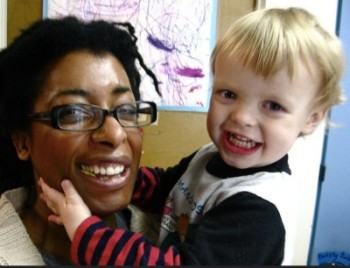Presence has never been harder or more needed – in this age of hyper transparency, connection, opinion and information, all in a media environment that’s networked, so that “speed of delivery” is a calculation of the past (it’s all just here already). Presence is needed by adults as much as children. It means different things to different people, including “attentiveness,” “focus,” and “mindfulness.”

I think of it as being consciously present – fully here – in this moment and with the person(s) and action in and of this moment. That can be at a kitchen table, in a videogame, a phone conversation, a board game, a lecture, an exchange of text messages or a deep philosophical debate. There is a certain peace or comfort in this conscious focus, a bit of distance from the drama and fire hose of incoming information and plain old noise.
Loving attention
Psychologist Kellie Edwards uses the word “mindfulness” in an article in the Huffington Post, pointing to a 2010 study showing that “the most important thing we can do for children is express love and affection by supporting and accepting them, being physically affectionate and spending quality one-on-one time with them.” [See “The Parents’ Ten” on p. 49 of this pdf of an article by the study’s co-author Robert Epstein in Scientific American.]
Interestingly, the second most important thing we can do for our children, according to the Epstein-Fox study, is “stress management” – reducing stress for ourselves and our kids, “practicing relaxation techniques” and “promoting positive interpretations of events.” And being present.
The trick – once we know how helpful it is to ourselves and our children – is in knowing and honoring what “present” means in each moment, and staying with it. That right there is a practice – just as much as meditation and relaxation techniques are. But what a wonderful everyday practice that we can commit to for ourselves and our children and model for them so that they can see – and feel – the value, the love.
A shared practice
“Mindfulness helps us train our attention skills so we can give [our children our loving attention] more easily. We can make choices to prioritize this,” writes Edwards. And what’s different about it from a personal practice is that we practice it together. Right in sync with our media environment, this is a shared practice that benefits all engaging in it in each moment.
I remember in the first national-level conversation about digital self-harm – teens, in effect, cyberbullying themselves anonymously – social media researcher danah boyd writing that this self-destructive behavior is a cry for attention. “Teens want their parents (and perhaps others in their lives) to notice them and pay attention to them, support them and validate them,” boyd wrote in her blog in 2010. This was after giving teens all over the US thoughtful focused attention in interviews about the digital parts of their lives. And in a post last fall, I cited clinical psychologist and author Catherine Steiner-Adair talking about how interviews with more than 1,000 children 3-18 consistently turned up “a kind of ‘relational fatigue’ with parents not paying attention [emphasis mine].” She said that, if we want our children to come to us when they find themselves in tough situations, we need to be three things: “approachable, calm and informed.”
Attentive to them, not just their media use
So that’s baseline: If we want to help our children use the media of their everyday lives effectively, mindfully and respectfully, we need to be attentive not merely to their media use but to them – and as best as we can remove the stress and fear from that attention. But this is about so much more than media and tech. We can help ourselves and our children navigate life as well as media by practicing presence – choosing and honoring what deserves our conscious attention, especially them, when appropriate – moment by moment.
So what’s the practice? I’ll repeat just in case you didn’t catch it up there: knowing and honoring what “present” means for you in each moment and staying with that – the person(s), the conversation, the activity – moment by moment. It may change in the next moment, but then you’ll be knowing and honoring that.
Practicing anything isn’t easy, but research and millennia of individuals’ efforts in practicing presence, show that this kind of practice brings immediate and long-term rewards for everybody involved. “Children benefit from highly attuned, responsive, sensitive, engaged, emotionally positive parenting,” writes Edwards. So do their parents, from that kind of attention, received and given.
Related links
- About danah boyd’s 2014 book, It’s Complicated: The Social Lives of Networked Teens
- How technology can improve the wellbeing of young adults
- “All kids deserve the safety & other benefits of social-emotional learning,” which research shows also improves academic performance
- “Balancing external with internal online-safety ‘tools'”
- “Neutralize the ‘negativity bias’ against kids’ net use”
- “When kids are skilled navigators of our networked world”
- A post I wrote about mindfulness in social media in 2011

Leave a Reply